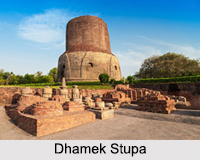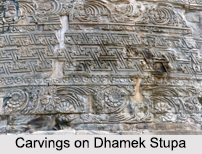 The Dhamek Stupa is a huge Buddhist stupa located about 13 km away from the city of Varansi in Uttar Pradesh. The stupa was built in 500 CE under the reign of King Ashoka, who built stupas to enshrine relics of Buddha and his disciples. There is an Ashokan pillar with an edict engraved on it that stands near the site.
The Dhamek Stupa is a huge Buddhist stupa located about 13 km away from the city of Varansi in Uttar Pradesh. The stupa was built in 500 CE under the reign of King Ashoka, who built stupas to enshrine relics of Buddha and his disciples. There is an Ashokan pillar with an edict engraved on it that stands near the site.
History of Dhamek Stupa
According to history, built in 500 CE, the Dhamek Stupa was a replacement of an earlier structure commissioned by the Mauryan king, Ashoka. This previous monument along with several others was built in 249 BCE to commemorate the activities of Lord Buddha in the area. It is known that stupas first originated as pre-Buddhist tumulis, which are basically burial mounds, where the ascetics were buried in a seated position, known as chaitya. After Lord Buddha"s attainment of enlightenment after death or parinirvana, his remains were cremated and the ashes was divided and buried under eight mounds with two further mounds encasing the urn and the embers. It has not been possible to identify the original ten monuments; however the stupas at Sarnath and Sanchi are believed to be the embellishments of the earlier mounds.
It is said that the Dhamek Stupa marks the spot, where Lord Buddha gave his first sermon to his five Brahmin disciples after attaining enlightenment, he revealed his "Eightfold Path leading to Nirvana". This famous event in the life of Lord Buddha is called the Dharma Chakra Pravartana or setting the Wheel of Law in motion. Thus, this specific spot where Buddha gave his sermons is known as the Rishipattana, which when translated means "where the Rishi arrived". In several of the ancient sources the site of the first sermon is mentioned to have been at a Mriga-dayaa-vanam or a sanctuary for animals. The last royal endowment at the site is dated to about 12th century CE, after which the location of the Mrigadayavanam seems to have been lost even to the devout. The Dhamek Stupa is known to be the place, which marks the foundation of the first Sangh with Buddha and about 60 other monks. This is also the place where Lord Buddha stayed and did meditation and thus marks as one of the four most sacred places associated with the Lord.
Architecture of Dhamek Stupa
The Dhamek Stupa in Sarnath is a cylindrical tower, which stands at a height of 44m and has a width of about 28 m. The basement is chiselled and depicts floral carvings of Gupta origin. The wall is filled with carved figures of humans, birds, geometric designs, and swastika along with inscriptions in the Brahmi script. The foundation of the stupa is made of very large bricks and has a depth of 28 ft below the level of the ruins. Except the upper 5 courses, the complete building is a solid mass of stone. These stone are secured by iron cramps. The upper part of the tower is built entirely of large bricks, however it has now disappeared.
The lower part of the Dhamek Stupa has eight projecting faces. They each stands at a height of 21 ft and is 6 inches in width with a gap of about 15 ft between each. There is a semi-circular headed niche that is 5.5 ft in width. They are located in each of the faces at a height of 24 ft above the ground and are about 5.5 ft in width. In each of the niches there is a pedestal, which are somewhat hollowed on the top. There were statues on top of them but now they cannot be seen any more.
 The eight projecting faces located at the base of the niches decrease in width to 5 ft at the top. However, this reduction is not uniform. Out of these eight faces, seven are beautifully decorated with a profusion of flowering foliage while the south face is entirely plain. The carving on some of the faces has been completed but others are not yet complete. A triple band of ornament, nearly 9ft in depth below the niches, encircles all the rest of the building, both faces and recesses. The middle band is the broadest and has been carved with various geometrical figures. The main lines are carved deeply and the intervening spaces can be seen filled with various ornaments. However, on some of the faces the spaces between the deeply cut lines have been kept plain. A lotus plant with leaves and buds has been carved on the upper band of the Dhamek Stupa. The lower band has full blown flowers as well as the buds. The lotus flower can be seen on all the sides except the south-west, which is represented with Chakwa or Brahmani goose seated upon it. A human figure seated on a lotus flower can be seen here. They hold two branches of the lotus in his hands. On each side of him there are three lotus flowers.
The eight projecting faces located at the base of the niches decrease in width to 5 ft at the top. However, this reduction is not uniform. Out of these eight faces, seven are beautifully decorated with a profusion of flowering foliage while the south face is entirely plain. The carving on some of the faces has been completed but others are not yet complete. A triple band of ornament, nearly 9ft in depth below the niches, encircles all the rest of the building, both faces and recesses. The middle band is the broadest and has been carved with various geometrical figures. The main lines are carved deeply and the intervening spaces can be seen filled with various ornaments. However, on some of the faces the spaces between the deeply cut lines have been kept plain. A lotus plant with leaves and buds has been carved on the upper band of the Dhamek Stupa. The lower band has full blown flowers as well as the buds. The lotus flower can be seen on all the sides except the south-west, which is represented with Chakwa or Brahmani goose seated upon it. A human figure seated on a lotus flower can be seen here. They hold two branches of the lotus in his hands. On each side of him there are three lotus flowers.
The Dhamek Stupa holds an important place at Sarnath as it signifies the "seat of the holy Buddha." Buddhist pilgrims of different countries visit this place for circumambulation of this sacred Stupa and to offer worship to Lord Buddha.
Visiting Information on Dhamek Stupa
The Sarnath Railway Station is only a mere km away from the Dhamek Stupa while the Varanasi railway station is about 9 km away from the stupa. The Lal Bahadur Shashtri International Airport, Uttar Pradesh is at a distance of 26 km from the Dhamek Stupa.



















